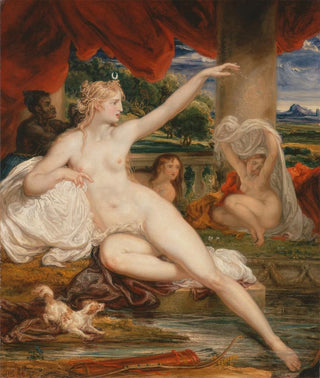Art print | Diane au bain - James Ward


View from behind

Frame (optional)
In the vast panorama of art history, certain works stand out for their ability to capture the very essence of humanity and nature. "Diane au bain" by James Ward is a perfect example. This canvas, both delicate and powerful, evokes timeless mythology while revealing technical mastery and aesthetic sensibility that transcend eras. Immersing oneself in this painting, the viewer is immediately transported to a universe where beauty and grace blend with the contemplation of a fleeting moment. Ward manages to immortalize a scene of the goddess Diane, symbol of hunting and nature, in rare intimacy, where light and shadow play a crucial role.
Style and uniqueness of the work
James Ward's style is characterized by meticulous attention to detail and a subtly nuanced color palette. In "Diane au bain," the composition is skillfully orchestrated, with each element arranged to guide the viewer's gaze through the scene. The delicate curves of Diane's body, the sparkle of water reflections, and the softness of the drapery create a visual harmony that enchants. Ward uses light to emphasize the sensuality and serenity of the goddess, while evoking an atmosphere of tranquility and contemplation. This painting, far from being a simple mythological representation, becomes a celebration of feminine beauty and nature—a tribute to the balance between man and his environment.
The artist and his influence
James Ward, a British painter of the 19th century, established himself as a major figure of his time. His work is marked by a deep fascination with mythology and nature, themes he explores with unique sensitivity. Ward, as an artist, was influenced by the great masters of painting, but he developed a style that is entirely his own, blending realism and romanticism. His innovative approach paved the way for many contemporary artists, who saw in him a role model. The way he manages to breathe an almost palpable life into his subjects is a characteristic that continues to inspire future generations. "Diane au bain" is thus not only a

Matte finish

View from behind

Frame (optional)
In the vast panorama of art history, certain works stand out for their ability to capture the very essence of humanity and nature. "Diane au bain" by James Ward is a perfect example. This canvas, both delicate and powerful, evokes timeless mythology while revealing technical mastery and aesthetic sensibility that transcend eras. Immersing oneself in this painting, the viewer is immediately transported to a universe where beauty and grace blend with the contemplation of a fleeting moment. Ward manages to immortalize a scene of the goddess Diane, symbol of hunting and nature, in rare intimacy, where light and shadow play a crucial role.
Style and uniqueness of the work
James Ward's style is characterized by meticulous attention to detail and a subtly nuanced color palette. In "Diane au bain," the composition is skillfully orchestrated, with each element arranged to guide the viewer's gaze through the scene. The delicate curves of Diane's body, the sparkle of water reflections, and the softness of the drapery create a visual harmony that enchants. Ward uses light to emphasize the sensuality and serenity of the goddess, while evoking an atmosphere of tranquility and contemplation. This painting, far from being a simple mythological representation, becomes a celebration of feminine beauty and nature—a tribute to the balance between man and his environment.
The artist and his influence
James Ward, a British painter of the 19th century, established himself as a major figure of his time. His work is marked by a deep fascination with mythology and nature, themes he explores with unique sensitivity. Ward, as an artist, was influenced by the great masters of painting, but he developed a style that is entirely his own, blending realism and romanticism. His innovative approach paved the way for many contemporary artists, who saw in him a role model. The way he manages to breathe an almost palpable life into his subjects is a characteristic that continues to inspire future generations. "Diane au bain" is thus not only a






